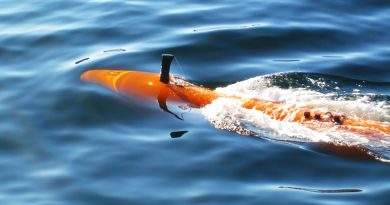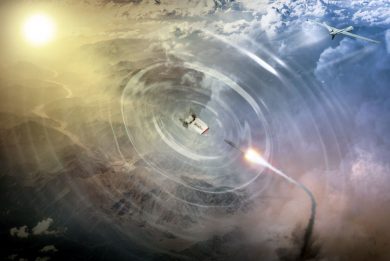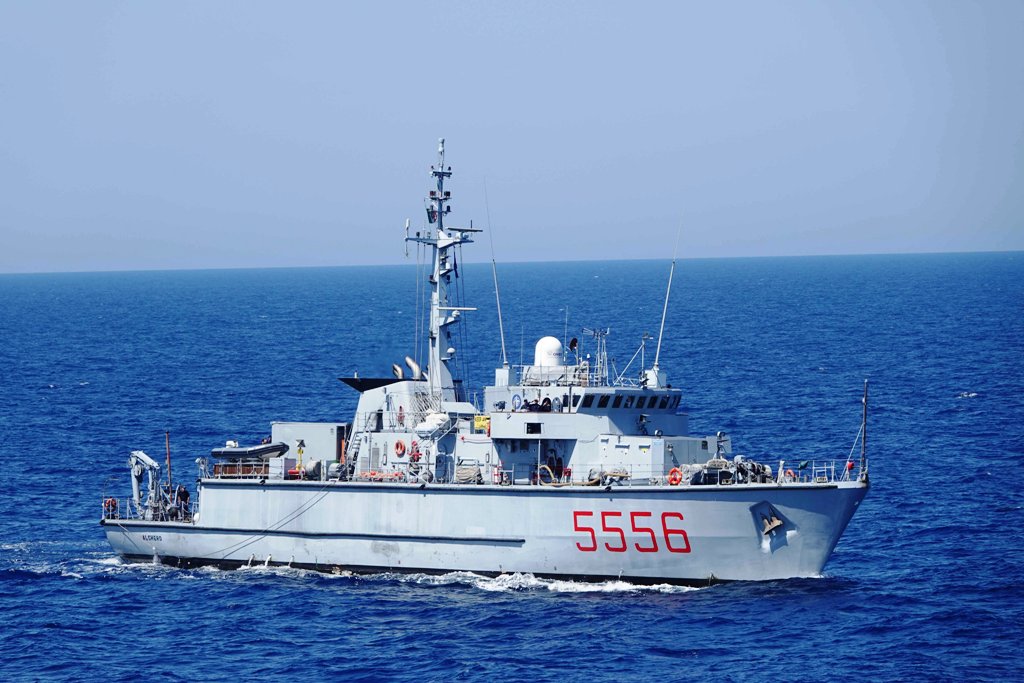
Seabed warfare, Italian Navy current and future MCM Force capabilities
The Italian Navy MCM (Mine CounterMeasures) Force Command, is silently involved since earlier last decade in the seabed warfare, ensuring the national underwater infrastructures’ surveillance and protection with manned and unmanned platforms and systems
“The surveillance and protection of underwater infrastructures of national interest is a well-known mission for the Italian Navy MCM Force Command since the beginning of the last decade, together with the mine and improvised explosive devices countermeasure warfare well before,” Rear Admiral (RADM) Gianguido Manganaro, head of MARICODRAG as his Command is usually called, told EDR On-Line during an exclusive interview aside the Seafuture 2023 exhibition and conference.
Under the direct command of the Italian Navy’s Fleet Commander (CINCNAV), MARICODRAG is headquartered in La Spezia and equipped with MCM vessels (MCMVs) and underwater remotely operated and autonomous vehicles to accomplish both missions, together with the preservation of underwater environment in support of other Government ministries and agencies, managing the Navy’s fleet of hydro-oceanographic and experimentation vessels, together with the two NATO-owned but Italian Navy-managed research vessels, Alliance and Leonardo.
“In addition to monitoring national waters, sea lines of communications and approaches to Italian ports, around 100 being periodically controlled by both MCMVs and underwater vehicle equipped teams, together with the disposal of war ordnances and the surveillance of national interest seabed installations such Oil & Gas pipelines and communication cables, MARICODRAG has been involved in international operations since the early 1980s in the Mediterranean and Persic Gulf basins.
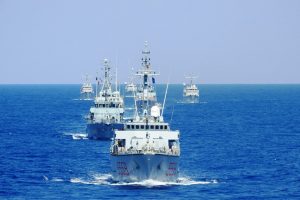
The Command makes available one MCMV with crew and support to the Standing NATO Mine CounterMeasures Group 2 (SNM-CMG 2) since its constitution – of which Italy takes the rotational command roughly every four years – in addition to national (such as the dedicated ITAMINEX exercise, and with the participation in other navies and fleet training events such as the Mare Aperto) and international exercises. MARICODRAG HQ staff is also available to provide an embarked operation command, as it happened last 12 June, when RADM Manganaro became the operation “Mediterraneo Sicuro” tactical commander for a two months rotation.
Based on a memorandum of understanding (MoU) signed in 2008, an exchange of personnel is carried out with the NATO Naval Mine Warfare Centre of Excellence and the Mine Counter Measures Vessel Operational Sea Training Centre, with a team of instructors qualified under the NATO MAREVAL course available to certify NATO MCM crews. Moreover, the MARICODRAG Training Centre is available for foreign crews qualification or support, as done in the recent past for the Algerian MoD. Interestingly, under an MoU signed in 1985 between the Italian MoD and the NATO Supreme Command (SHAPE), a MARICODRAG section manages the Mine Warfare Data Centre (MWDC) where all data regarding international waters seabeds and water column collected by NATO countries in the Mediterranean, Black Sea, Red Sea, Aden and Arabic/Persic Gulf are fused together and stored in order to provide a continuously updated database for future operations.
“MARICODRAG has a fleet of 10 MCMVs including eight Gaeta-class and two Lerici-class platforms. Gaeta-class vessels represent the latest iteration of GRP (Glass-Reiforced Plastics) MCMVs developed and built by Intermarine for the Italian Navy between 1992 and 1996. By the end of 2023, the Rimini will be the last of these active vessels subjected to a mid-life update (MLU) programme which requires an average of two years for each platform to be returned to service, with a key difference compared to the previous vessels”, RADM Manganaro told EDR On-Line. This modernisation plan also involves remotely operated vehicles in use by the Command for both shipborne and expeditionary missions.
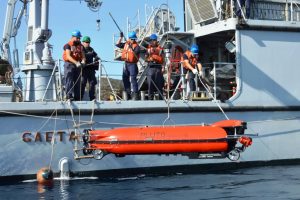
Under the MLU, each Gaeta-class platform has received the Thales Underwater Systems Type 2093 variable depth sonar (VDS), which significantly increased the MCM capabilities, together with a new MCM command and control suite by Datamat, now part of Leonardo, the latter company also providing new radio/SATCOM communications equipment. The update also includes extensive modifications to the stern main deck and superstructures area for a better accommodation of ROV/AUV and a hyperbaric chamber for the divers detachment. Two new launch and recovery cranes are installed and are used to launch the two embarked RHIBs as well as ROVs. “Each Gaeta-class MCMV is equipped with a Pluto Plus and a Pluto Gigas ROV/AUV provided by Gaymarine that allow our platforms to operate up to 600 meters (Pluto Gigas) for MCM and other seabed and infrastructure surveillance operations. These vehicles are currently being enhanced thanks to a service life extension programme that, in addition to their digitalisation, will also include new and more capable sonars.
The hydro-oceanographic fleet, consisting of the two smaller Aretusa-class and larger but aged Magnaghi platforms, supports the Hydrographic Command needs, while the Italian Navy-managed research vessels, Alliance and Leonardo, support both the NATO Centre for Maritime Research and Experimentation (CMRE) and Italian missions mainly with the Alliance in the Arctic region. In December 2022, Fincantieri received a contract for a new larger hydro-oceanographic vessel (NIOM) to be delivered in 2026 and equipped with state-of-the-art sensors and unmanned systems for dual-use duties.
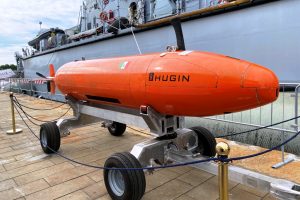
“Unlike previous Gaeta-class MCMVs subjected to the MLU, the last platform is being fitted for embarking one 20’ and one 10’ containers as part of the launch, recover and command and control module for operating a Kongsberg Maritime HUGIN AUV capable to operate up to 3,000 meters depth. The new air deployable module will allow the use by other Italian Navy ships or vessels of opportunity, in addition to expeditionary missions without naval platforms,” RADM Manganaro explained. “In addition to deploy the first generation of Pluto MCM vehicles in the late 1980’s, MARICODRAG began to use AUVs since 2009, when the first Remus 100 was delivered. Our Command became one of the first European operators of long endurance and deep operation AUVs, inducting into service the first HUGIN vehicle for operations up to 3,000 meters depths in 2013. The latter is capable to be deployed by the modified Vieste MCMV, one of the two older Lerici-class platforms still in service,” RADM Manganaro said. “MARICODRAG is expected to receive a second 3,000 meters capable HUGIN AUV by the end of 2023 that will be used aboard the Rimini MCMV as well as for expeditionary operations”, he announced. According to Italian MoD Naval Armaments Directorate documentation, a third HUGIN is under procurement.
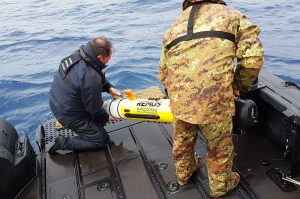
“Together with larger AUVs, MARICODRAG routinely uses the Remus 100 as demonstrated by its recent deployment in Qatar as part of the Italian Defence contribution to the FIFA World Soccer 2022 event protection. In the incoming months we are going to receive two new Remus 300 AUVs equipped with latest generation high resolution Kraken Robotics Synthetic Aperture Sonar systems,” RADM Manganaro unveiled. At least two more are under procurement according to the Italian MoD Naval Armament Directorate documentation.
“With the entry into service of the HUGIN AUV in 2013, MARICODRAG developed, and has since deployed, the capability to monitor large deep seabed areas and infrastructures not only for security and defence operations but also for research and monitoring duties in support of government agencies and civil organizations. This in addition to the MCMVs and Pluto family ROV/AUVs deployment, and the cooperation for the same activities with the divers component (GOS, Gruppo Operativo Subacquei) of the Italian Navy’s COMSUBIN Command, alongside operations up to 60 meters with MARICODRAG qualified divers, thanks to the hyperbaric chamber embarked on MCMVs.”
“With the higher protection level dictated for seabed infrastructures after the North Stream gas pipelines sabotage, in September 2022 the Italian Navy launched Operation’ Fondali Sicuri’ (Secure Seabeds). Information coming from every fleet component , including surface, underwater and air assets, as well as other armed forces and agencies, are fused at the Navy’s Fleet Command (CINCNAV) to monitor traffics and highlight connected anomalies or specific vessels of interest operating nearby underwater infrastructures,” RADM Manganaro continued. To cope with these specific monitoring activities, MARICODRAG makes available one MCMV and ROV/AUVs under operation “Mediterraneo Sicuro” (but more assets could be alerted in case of multiple operations) that also conducts pre-planned surveys of main seabed infrastructures including the gas pipelines connecting Albania, Tunisia and Libya to Italy, as well as main communications backbones. More recently, in the framework of Operation “Fondali Sicuri”, MARICODRAG’s Gaeta MCMV and the French Pluton diving support vessel worked together for the control of the Trans Adriatic Pipeline (TAP), fully sharing of operational procedures.
Looking to the future of the specialty, the Italian MoD Naval Armament Directorate launched a risk-reduction study to replace the current single class of platforms with a new generation of coastal and high-seas MCMVs, the latter capable to operate in expeditionary forces for long periods away from the homeport. For this project, the Italian Navy is working with Intermarine and other national partners like Leonardo to develop a new family of MCMVs that should start entering into service in 2028. In addition to the Italian Navy, Intermarine has so far provided MCMVs to the US, Australia, Finland, Algeria, Thailand, Malaysia, Nigeria, and after the decommissioning of US Navy platforms, six of them were transferred and are in service with Taiwan, Greece and Egypt. “Maritime unmanned systems will be the future, taking the man out of the minefield. However the Italian Navy believes we are still in a transition phase where the legacy capability cannot be completely abandoned and lost. Based on the Italian MCM force experience, we are looking to a concept of operations based on a very modern and flexible MCM platform able to safely approach a minefield and deploy unmanned system wherever and whenever is necessary. In our job we do not know when we enter a minefield, therefore the new MCMV will have to feature the same shock resistance and underwater low signature of legacy MCMVs like the Gaeta-class platforms, making a massive use on unmanned systems in a multidomain environment,” RADM Manganaro concluded.
Photos courtesy Italian Navy and L. Peruzzi


